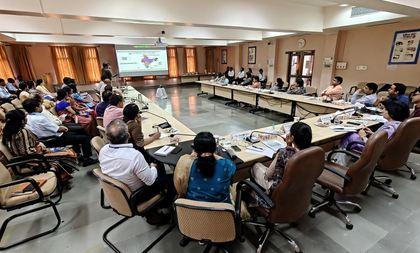One Health Mission studying migratory birds, slaughterhouses to prevent zoonotic spillovers: ICMR-NIV
By IANS | Updated: June 19, 2025 15:53 IST2025-06-19T15:46:56+5:302025-06-19T15:53:51+5:30
Pune, June 19 In a bid to check and prevent zoonotic spillovers, the National One Health Mission is ...

One Health Mission studying migratory birds, slaughterhouses to prevent zoonotic spillovers: ICMR-NIV
Pune, June 19 In a bid to check and prevent zoonotic spillovers, the National One Health Mission is studying migratory birds and slaughterhouses to prevent zoonotic spillovers, said Dr Naveen Kumar, Director at the ICMR-National Virology Institute (NIV) here.
The National One Health Mission (NOHM), launched in 2022, embraces the One Health approach, and is a marked shift from reactive responses to proactive preparedness.
Zoonotic diseases are those that can spread between animals and humans.
"Of the infectious diseases, particularly the viral diseases, more than 70 per cent are zoonotic in nature," Kumar told IANS.
"That means, if you want to control the disease in human, you have to control or need to adopt the measures to controlling the disease in animal the vectors in environment," he added.
As this is not possible without an integrated approach, the NOHM was initiated with the coordination of 13 or more Ministries/Departments, Kumar noted.
This includes the Ministries of Health and Family Welfare, Fisheries, Animal Husbandry and Dairying, Environment, Forest and Climate Change, Agriculture and Farmers Welfare, Science and Technology and AYUSH among others.
Together, these have established robust surveillance systems across human, animal, and environmental health.
Kumar told IANS that the need for the mission was felt during the Covid-19 pandemic, when only the NIV was active with a Bio-Safety Level (BSL) - 4 lab -- the highest containment facility where you can work on the viruses and it is not going to leak outside the lab.
"During the middle of the pandemic, it was realised that if we would have more labs like we have in NIV, so our response time could have been much shorter as compared to what it was during the Covid pandemic," Kumar said.
Under the NOHM, there is going to be one separate centre, the National One Health Institute in Nagpur.
In addition to the construction work, the Institute has also begun the scientific work.
"The National One Health Institute will undertake the active surveillance of different viruses in humans as well as in different animals, wildlife, insect and other vectors," Kumar said.
For this, a national network of BSL-3 lab has been set up, where the high-risk group of pathogens can be handled.
Further, four zonal NIVs are also likely to be established -- Bengaluru (south), Jammu (north), Dibrugarh (east), and Jabalpur (centre).
In case of emergency, these labs can be utilised to respond to the pandemics, Kumar said.
One way we are getting the new viruses is via the migratory birds, the Director noted.
"In winter-time, lot of the migratory birds from northern hemisphere, they are coming to India, and they are maybe coming up with the new viruses and the animals or humans who are in close contact in vicinity of these migratory birds, so their spillover infection can take place," Kumar said.
The unique study, launched in April by ICMR, will be conducted in select bird sanctuaries and wetlands across Sikkim, Maharashtra, and Tamil Nadu.
The study aims to develop a real-time surveillance model to detect and diagnose zoonotic diseases in bird sanctuary workers and nearby residents.
It will involve periodic sampling of birds and environmental specimens to screen for emerging pathogens, utilizing advanced diagnostic tools like Next Generation Sequencing (NGS) for the early identification of novel infections.
Likewise, another way that we are the spillover infection can take place is the slaughterhouse, where the animal and human interfaces, they interact, Kumar said.
"We are also having a network project on slaughterhouse which is closely monitoring the people, humans who are working there, animals and environment" he added.
With these activities under national one health mission, the NIV is playing a crucial role as resource institute providing training and the capacity building to various stakeholders, Kumar noted.
Disclaimer: This post has been auto-published from an agency feed without any modifications to the text and has not been reviewed by an editor
Open in app